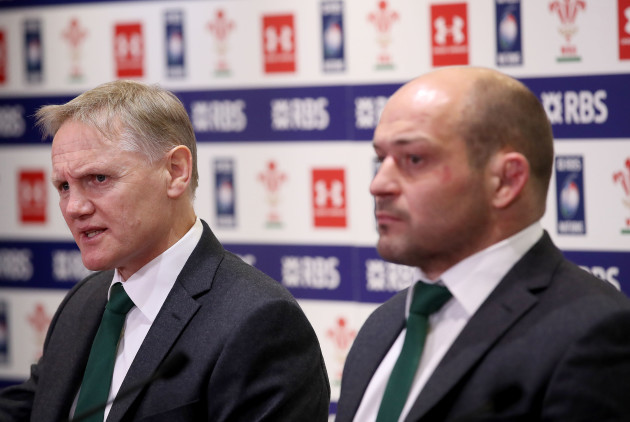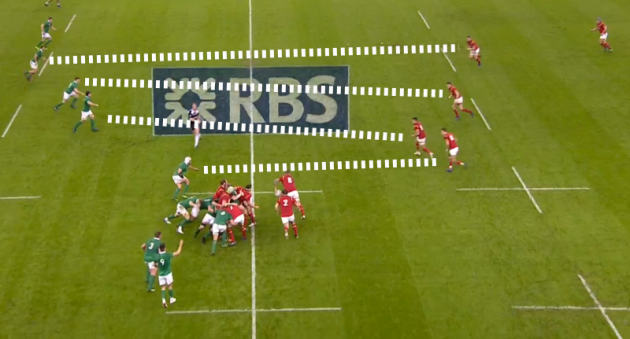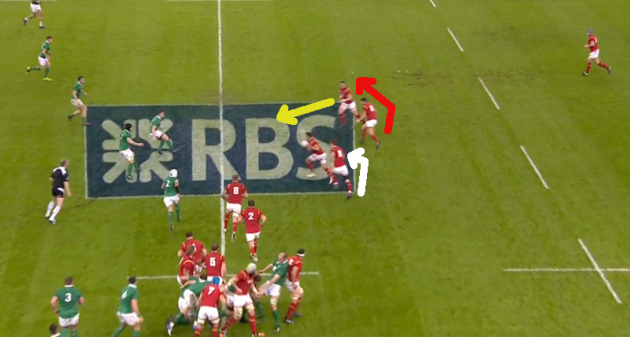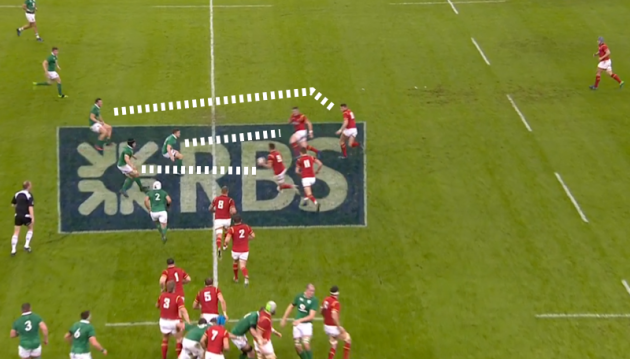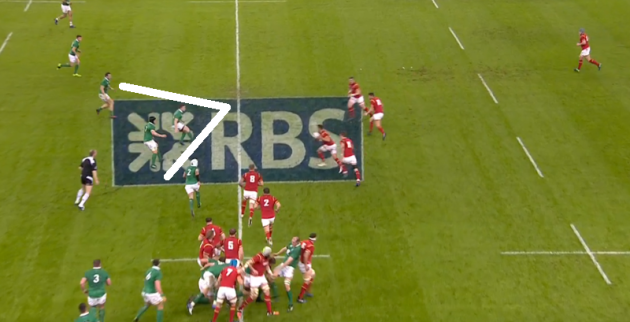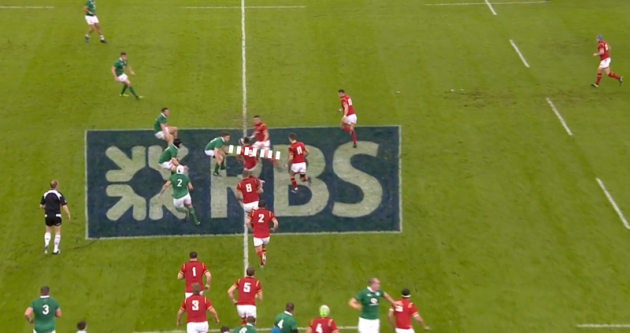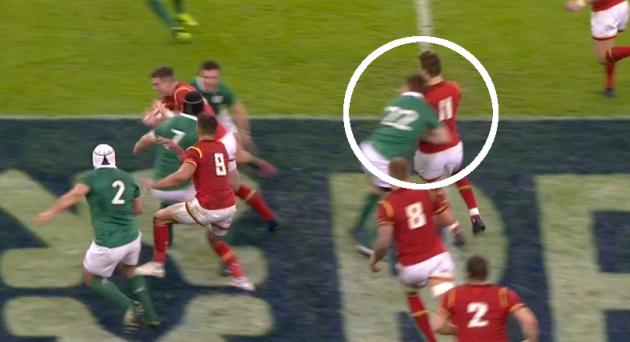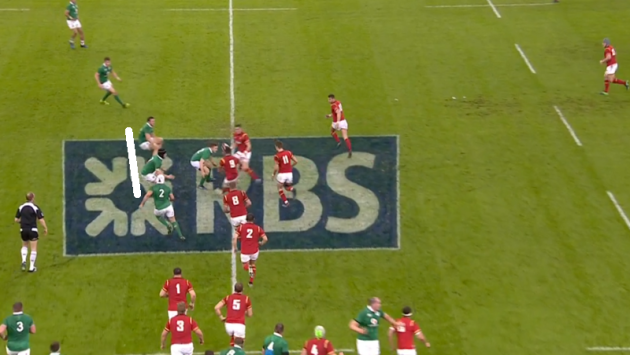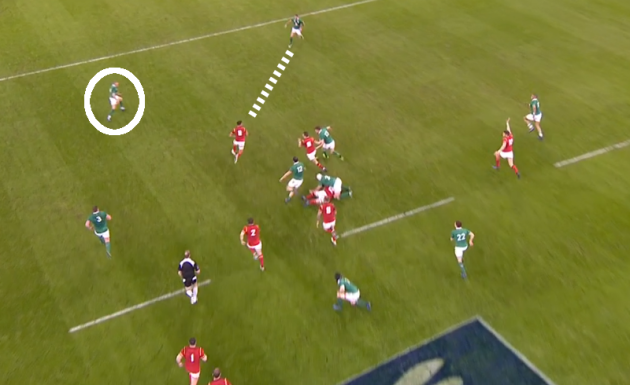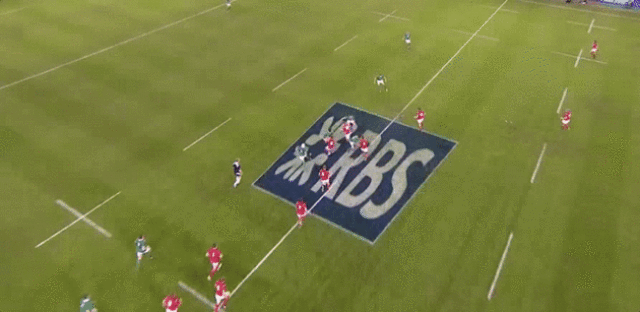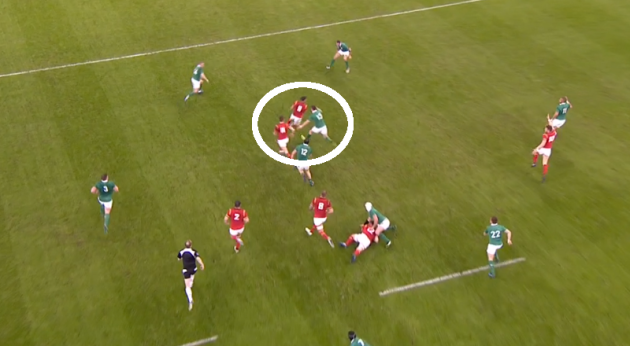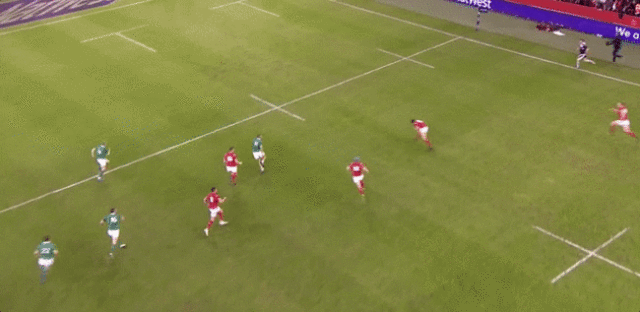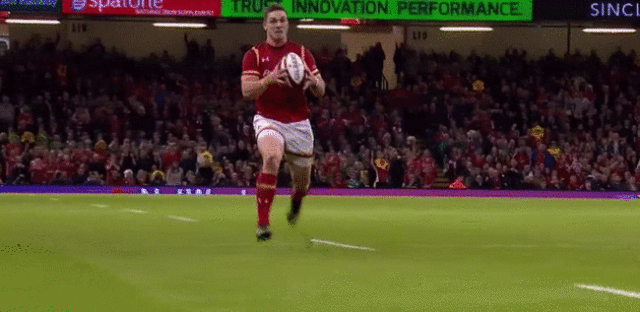WHILE JOE SCHMIDT tends not to criticise individual players in press conferences after games, Paddy Jackson didn’t come out of the post-Wales review very well.
The Ulsterman only spent around 13 minutes on the pitch, replacing Johnny Sexton during the starting out-half’s HIA and then permanently in the 79th minute.
But even in that short space of time, Jackson contributed an error which Schmidt referred to twice post-match, both times unprompted.
“They attacked well, especially when Johnny went off to get checked out and they went straight through around his area. I think it’s something that we’ll learn from,” said Schmidt first, before then mentioning it in more detail later and naming Jackson:
“I really did feel that our first 15 minutes, we put them under some huge pressure and got very close to scoring. Unfortunately, we lost Johnny and lost a little bit of leadership and you don’t need to give Scott Williams too many invitations to break the line.
“He hit a nice line on a good change-up and we weren’t quite connected, but it was very tough for Paddy just coming on, to suddenly slot straight into that. But, again, that’s a learning experience and I honestly think that you can profit from that further down the line. That’s a challenge for us and we have to make sure that’s what the case is.”
It’s far from a slating from Schmidt – and he did also mention that Jackson “did some pretty good things when he came on later in the game, almost slipped through a couple of times” - but it’s quite clear that the head coach wasn’t pleased.
We see the incident Schmidt is referring to below.
It’s Jackson’s first involvement in the game after replacing Sexton and he obviously wants to make an impact.
He rushes up hard, bringing great linespeed, but Jackson’s eagerness means he gets disconnected from Sean O’Brien on his inside and Robbie Henshaw on his outside, creating the ‘dog leg’ that Wales exploit superbly.
We spoke about the Welsh threat from simple set-piece attacks last week, and it’s certainly an area Ireland would have spent time working on, hoping to ensure they shut down Rob Howley’s men. But in this instance, Ireland get it wrong.
As Wales play off their six-man lineout, using a dummy maul after Sam Warburton wins the ball, we can see that Ireland’s defensive duties are quite clear.
Sean O’Brien is part of the ‘backline’ defence, not having been required in the lineout, and he is pointing at first receiver Rhys Webb.
Rory Best is coming from the ‘tailgunner’ position at the rear of the lineout and covers any possible inside pass from Webb to Liam Williams.
Outside O’Brien, Jackson is in position to mark up on Dan Biggar, while Robbie Henshaw is lining up on Wales centre Scott Williams at this point.
Of course, the picture changes for Ireland in a split second as Wales put their clever set-piece plan into action and bring movement to challenge the Irish defenders.
Scott Williams runs a hard line back against the grain [yellow below], while Biggar bounces out behind him [red], fading away from the ball. Liam Williams tucks himself in behind Webb, providing another possible passing option [white].
That means a shifting of the defensive duties for Ireland.
O’Brien is still lined up to deal with ball carrier Webb, but Jackson’s duty shifts to dealing with Scott Williams coming on that hard, flat line to Webb’s right shoulder, while Henshaw worries about Biggar getting the ball on a screen pass behind Scott Williams.
Best, coming from the lineout, is plugging the inside for Ireland.
It looks fairly simple above, but we are of course not taking into account the presence of Liam Williams in this shot.
The real beauty of this set-piece play from Wales is how Williams attracts Irish attention at the last split second.
Williams’ positioning serves to accentuate the ‘dog leg’ that has been created in Ireland’s defensive line by Jackson racing up ahead of O’Brien and Henshaw.
While it seems obvious that Jackson should be focusing on Scott Williams arriving on a hard line to the right of Webb, he appears to be drawn by Liam Williams at the last moment.
It’s an understandable decision from Jackson to be attracted by the presence of Liam Williams.
In the round two defeat to England, Liam Williams did get the ball on an extremely play – although off scrum – to this one, breaking through for a try after receiving the pass from Webb behind Scott Williams.
It appears that that specific incident – which Ireland would have analysed, as we did on The42 Rugby Show – flashes into Jackson’s mind here and he appears to decide that he must deal with Liam Williams.
We can see above that Jackson gets his hands on Liam Williams but the pass has, of course, already gone in front of him from Webb to Scott Williams, who is in the process of bursting past O’Brien and Henshaw.
We know now that Jackson’s late decision to engage with Liam Williams was the wrong one, but he is actually marking an attacking threat.
In an ideal world, Henshaw might have had enough time to step in on Scott Williams in time to get a big shoulder onto him, with Garry Ringrose outside him hammering up on Biggar, but of course Ireland don’t have that luxury with the Welsh running at the gain line.
Liam Williams in behind is a real ‘floating’ conundrum for Ireland, but again the presence of the dog leg means they cannot re-adjust to more comfortably cater for his threat.
Had Ireland’s defensive line remained properly connected, with Jackson alongside O’Brien and Henshaw in the line indicated above, they would have had far greater scope for making good decisions and getting shoulders on to the eventual ball carrier.
But Jackson isn’t simply ‘tackling air’ as had appeared to be the case on first viewing.
While it certainly would have been far better for Ireland if Jackson had focused on tackling Scott Williams, we must stress again the ingenuity of the Welsh set-piece attack.
So it is that Webb hits the barrelling Scott Williams, who actually slows his run in order to time his arrival onto the ball perfectly.
Ireland react poorly to what is a bad situation to be in.
Henshaw can’t get a shoulder onto Williams as he turns in, while O’Brien can also only get a hand onto the powerful Welsh centre, who brushes right through the arm tackle.
Best, coming from the lineout, manages to desperately cling on to Williams, grounding him, but we then see the value of Webb staying alive and getting upfield after his own pass to Williams.
Webb is in position to receive the ball back from Williams in behind the defence, and now the Irish backfield attempts to redeem the situation for Ireland.
Webb is initially running at right wing Keith Earls [circled below], but he then arcs to his right and that engages Rob Kearney into coming forward to deal with him, as we see below.
Earls [circled above] cleary has concerns about a pass to Webb’s left side, and initially hovers in that area.
Of course, Webb produces a stunning pass wide to his right in the end, a beautiful moment of skill on the move, getting the ball away just before Kearney can tackle him.
Ringrose is tracking Liam Williams’ run in behind Webb, although the Irish outside centre might wonder he should have dived and hit Webb with as much force as possible at the moment indicated below.
Let us stress once again how easy it is to discuss incidents like this one with the benefit of multiple replays and various angles, rather than in the intense and ferocious pace of a Test match.
Ringrose appears to be worried about Webb making the switch pass to Liam Williams here, but he’s within touching distance of the scrum-half and might feel he could have got a bigger contact onto him.
Leigh Halfpenny collects the sensational pass from Webb, carries the ball for six steps and makes an excellent decision to hit George North – giving him time and space to finish.
It’s obviously an outstanding finish from North for Wales, but again Ireland will feel they could have done more to prevent the try, even at this late stage.
While North moving at speed and bearing down on the tryline, Ireland still have some space to work with in halting him.
Simon Zebo has been engaged briefly by Halfpenny, so Earls – sweeping across all the way from the right – is now the last defender for Ireland.
If he’s going to have any chance of halting or significantly slowing North, Earls simply has to get a strong shoulder onto the Welsh wing. There is the initial benefit of the touchline for Earls, and he appears to expect to have to make the tackle on his outside.
That means that Earls continues running at the sprinting pace that has brought him across in the first place, and North uses that against him by stepping strongly off his right foot and inside Earls.
It means that Earls must re-adjust and turn back inside in a split second and, as we see above, he cannot get a firm shoulder onto North and the imposing Welshman brushes through the arm tackle.
Zebo does manage to get his hands onto North and cling on, but the Welsh wing brushes him off this upper body and by the time Zebo is slipping down to take out his legs, North is already over the tryline.
Clearly, the greatest damage from Ireland’s point of view was done with the initial linebreak from the set-piece, but they will feel they could have done better to halt the clinical Welsh in behind their line.
Schmidt’s assessment of Jackson’s role in this try concession will likely sting for the Ulster out-half, but it’s clear that he was not the only Irish player involved.
While Jackson’s creation of the dog leg in the defence and his misread of the Welsh target were damaging, the try is certainly one that we should be crediting Rob Howley and Wales attack coach Alex King for.
Their simple set-piece attack has been an important feature of their game in this Six Nations and it will be riveting to see what variations they bring next weekend against France in Paris.
Subscribe to The42 Rugby Show podcast here:
